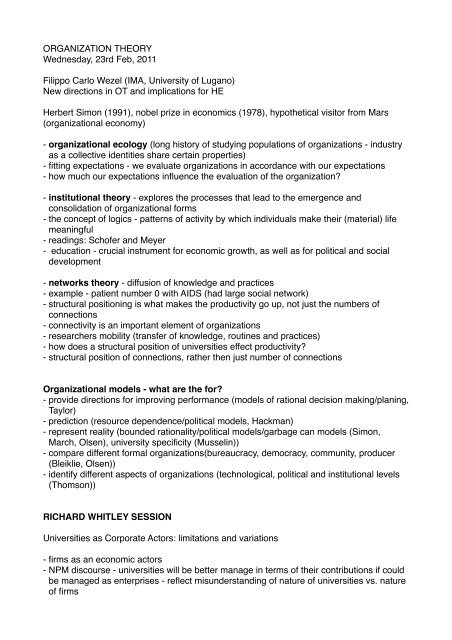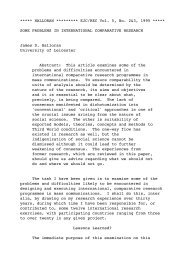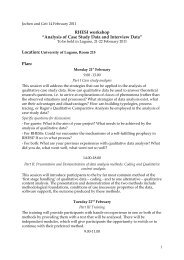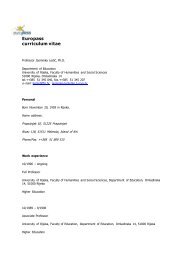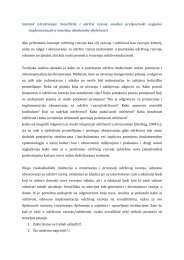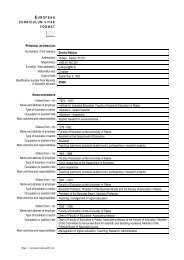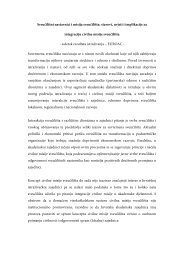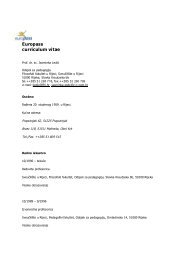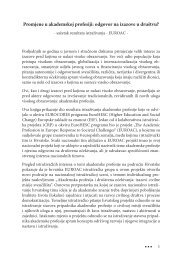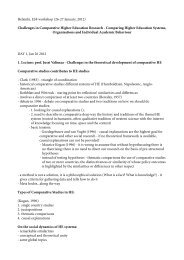OT_BCulum notes - euroac
OT_BCulum notes - euroac
OT_BCulum notes - euroac
You also want an ePaper? Increase the reach of your titles
YUMPU automatically turns print PDFs into web optimized ePapers that Google loves.
ORGANIZATION THEORY<br />
Wednesday, 23rd Feb, 2011<br />
Filippo Carlo Wezel (IMA, University of Lugano)<br />
New directions in <strong>OT</strong> and implications for HE<br />
Herbert Simon (1991), nobel prize in economics (1978), hypothetical visitor from Mars<br />
(organizational economy)<br />
- organizational ecology (long history of studying populations of organizations - industry<br />
as a collective identities share certain properties)<br />
- fitting expectations - we evaluate organizations in accordance with our expectations<br />
- how much our expectations influence the evaluation of the organization?<br />
- institutional theory - explores the processes that lead to the emergence and<br />
consolidation of organizational forms<br />
- the concept of logics - patterns of activity by which individuals make their (material) life<br />
meaningful<br />
- readings: Schofer and Meyer<br />
- education - crucial instrument for economic growth, as well as for political and social<br />
development<br />
- networks theory - diffusion of knowledge and practices<br />
- example - patient number 0 with AIDS (had large social network)<br />
- structural positioning is what makes the productivity go up, not just the numbers of<br />
connections<br />
- connectivity is an important element of organizations<br />
- researchers mobility (transfer of knowledge, routines and practices)<br />
- how does a structural position of universities effect productivity?<br />
- structural position of connections, rather then just number of connections<br />
Organizational models - what are the for?<br />
- provide directions for improving performance (models of rational decision making/planing,<br />
Taylor)<br />
- prediction (resource dependence/political models, Hackman)<br />
- represent reality (bounded rationality/political models/garbage can models (Simon,<br />
March, Olsen), university specificity (Musselin))<br />
- compare different formal organizations(bureaucracy, democracy, community, producer<br />
(Bleiklie, Olsen))<br />
- identify different aspects of organizations (technological, political and institutional levels<br />
(Thomson))<br />
RICHARD WHITLEY SESSION<br />
Universities as Corporate Actors: limitations and variations<br />
- firms as an economic actors<br />
- NPM discourse - universities will be better manage in terms of their contributions if could<br />
be managed as enterprises - reflect misunderstanding of nature of universities vs. nature<br />
of firms
Firms vary considerable in governance and organizational capabilities<br />
The governance of firms varies in three major ways:<br />
1. the degree of autonomy from investors, banks and other sources of finance<br />
2. degree of dependence on skills employees for problem solving and capability<br />
development<br />
3. degree of dependence on suppliers, customers and collective associations for<br />
innovation, knowledge and capabilities<br />
Three distinct types of organizational capabilities:<br />
1. coordinating<br />
2. organizational learning (developing routines)<br />
3. reconfiguring<br />
Friday, 25th Feb, 2011<br />
The New Institutionalism (Uwe Schimank / Frank Meier)<br />
Reading: meyer/rowan:<br />
- look at individual organization<br />
- empirical starting point - similarity of organizations<br />
- no existence of “one best way”<br />
- weber and taylor - efficiency and effectiveness are main goals in organizational<br />
development<br />
- actions are strongly shaped by institutions (neoinstitutionalism) - institutions are patterns<br />
which gives solutions: this is how it should be done; patterns are taken for granted, no<br />
alternatives, everything else would be called irrational, immoral, even crazy<br />
- organizations must ask themselves: what is rational?<br />
- institutions: legitimate patterns<br />
- rationality - not primarily orientations of organizations, but secondary<br />
- primary: equisition of legitimacy by the organization (it can be doe by conforming<br />
institutional patterns of rationality)<br />
- nobody knows what is really rational, but what is consider to be rational - “rational<br />
institutional myths”<br />
- institutional patterns vs. actual needs and practice - “de-coupling” as a solution<br />
- talk vs. action - organizational hypocrisy<br />
DiMaggio/Powell, 1983<br />
- what does this pattern means for the organizational field/for the organizational society -<br />
the concept of Isomorphism (this is their starting point and answer)<br />
- common search for legitimacy which organizations must have<br />
- competitive pressures<br />
- only limited number of organizational structures survive over time on highly competitive<br />
market (similar to ecology population)<br />
- isomorphism not because of the competitive external pressures but due to institutional<br />
pressures!!!
Three mechanisms of institutional isomorphism:<br />
- coercive isomorphism (government make new roles that pose to the university, NPM)<br />
- normative isomorphism (organizational structures are prescribed; often used as an<br />
explicitly policy of change in institutions - institutions will recruit people with only, e.g.<br />
MBA i these people will shape the institutions and its structures and changes by the<br />
knowledge they have so far)<br />
- mimetic isomorphism (every organization is asking themselves what do other<br />
organizations do? and copy-paste is usually happening - this reflect the organizationsʼ<br />
uncertainty between their means and end/goals - the greater uncertainty there is, the<br />
greater possibility that organization will copy other organizations that find similar to itself)<br />
DiMaggio, 1988<br />
- merits and limits of institutional theory<br />
- no common agreement on the theory of actor, nor on the theory of institutional action and<br />
change<br />
- implicitly: interest-driven behavior<br />
- 2 universal interest of organizations and actors: (I) interest in certainty and predictability<br />
and (II) survival - they provide stability, possibility to predict future events<br />
- institutions strive to gain and to maximize their legitimacy, and legitimacy is necessary<br />
prerequisite for survival<br />
- his most essential focus is on the question how do institutions change? Answer: if actors<br />
are intentionally trying to effect to institutions, the dynamics of institutions, its creation<br />
and reproduction<br />
- Politics of Institutionalization<br />
- institutional work - the concept of institutional work is an attempt to shift the<br />
focus to purposive actions of individuals and/or organizations within the neoinstitutional<br />
framework - institutional work implies activities rather then<br />
accomplishments + cognitive and/or physical efforts involved (Lawrence et al.<br />
2009)<br />
- institutional entrepreneurship (in the last decades lots of papers have been<br />
published within the filed of institutional entrepreneurship, looking for the powerful<br />
actors)<br />
Lawrence/Suddaby/Leca 2008<br />
- broader idea of intentional actor trying to change institutional structures<br />
- we donʼt need to have one powerful actor, but several actors that are not powerful, do not<br />
possess much resources - distributed agency<br />
- institutional work - the purposive action of individuals and organizations aimed at<br />
creating, maintaining and disrupting institutions<br />
- broader concept - it includes institutional entrepreneurship but also other actions that can<br />
affect institutional dynamic<br />
- it is institutional work when there is intention to affect institutional change<br />
- broad, open concept, they did not want to exclude any kind of work/action on institutional<br />
work
- there is much more to discuss in the field of institutional theory (presented papers and<br />
concepts have been receiving much attention during the last decade; it would be wrong<br />
to say they are the most important one, but obviously receiving attention and being more<br />
and more published)<br />
- Scandinavian institutionalism: imitating, translating, editing<br />
- Theory of the society: (might be important to our work/projects)<br />
- world polity (Meyer: globalize environment; broad framework on how are nationstates,<br />
institutions-individuals connected;: very broad approach in geographical<br />
sense, broad in sense we have fundamental institutional ideas and content about<br />
the moral and the ontological and theoretical relation between organizations and<br />
their environment),<br />
- inter institutional system (institutional logics) - logic of the market, logic of the<br />
state, religion, profession...<br />
- institutional theory is not a theory of conflicts but we find in it much of the explanations<br />
for the expected conflicts on all the levels<br />
Reading: Kruzer 1975: The complexity of roles as a .... as autonomy<br />
Peter, reading presentation<br />
TRUE - to what extent have universities been transform from loosely coupling to more and<br />
tightly organization, from incomplete to complete organizations?<br />
- focus on university governance structures (boards, specifically with external members)<br />
- with the introduction of board, traditional formal university governance structure has been<br />
changed<br />
- path dependence<br />
- decoupling - degrees of decoupling? first description but the the effects of decoupling?<br />
explaining differences - path dependency of degrees of coupling? causal relationships!<br />
- window of opportunities<br />
EUROAC - HEPROS and New Institutionalism<br />
RHESI - institutional work and educational sciences in Germany


